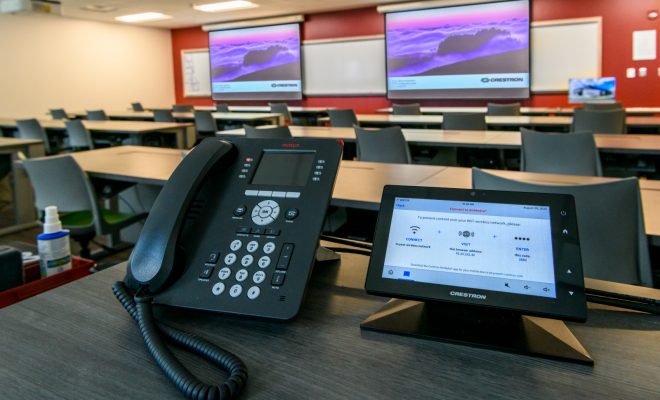What Roles Do IT Professionals Play in Schools?

Because the devices that provide local area networks and internet access in schools are the same as those installed in other businesses and industries, many IT roles filled in schools are similar to those in other organizations. Because the devices are the same, IT professionals may also play a similar role. However, several types of IT work in schools that are not found in other organizations. Schools are also known to be organizations with understaffed IT departments. As a result, it is not uncommon for individuals to play multiple roles, and it is also not uncommon for individuals to expand and enhance their technology skills working in schools and gain experience in new roles. This is one reason school may be an excellent place to start an IT career.
One of the realities of working in schools as an IT professional is that other stakeholders often do not differentiate technology roles. IT professionals recognize this is not unique to schools. When someone from “IT” appears, they will be asked to troubleshoot or resolve problems they were not expecting and that they are not prepared to resolve. IT professionals find it necessary to tactfully explain that they have higher priorities at the moment or that they do not have the skill or the authority to solve their problems. Further, IT professionals sometimes find it necessary to explain why some problems have not been resolved.
The IT departments in schools comprise a wide range of professionals who are managed by the chief information officer. Each IT professional applied specific expertise to fulfill specific roles for specific audiences (see table 1). Schools are organizations in which the titles applied to IT positions are very inconsistent. In some schools, a “technology coordinator” may serve as the chief information office (as I define it below), while in a nearby school, a technology coordinator may serve as a technician. For this reason, clean and accurate job descriptions are necessary to ensure qualified applicants apply and are hired.
Technicians
Technicians are the professionals who have one of the most important roles in school IT system operations; these individuals are the face of the IT department to most members of the school. A technician is likely to spend their day troubleshooting and repairing end-user devices, including desktop computers, laptops, Chromebooks, printers, and other peripherals. Because these professionals spend their time interacting with teachers and learners, it is important they have good customer service skills and are good at interacting with teachers when they are in stressful situations and with frustrated students.
On those staff with several technicians, the group can be very interdependent; they work together on solving problems, and they share what they have learned about the systems and the users of systems. By documenting the repairs that they make (ideally in a ticketing system), technicians contribute to the emerging knowledge of the IT system and help identify those devices that need to be replaced. As professionals who understand IT and who observe users interacting with it the most, technicians are also the first to identify potential problems that are emerging and unmet needs that the CIO and other professionals must plan to address.
Technicians may be hired with a wide range of qualifications. One can develop the expertise they need to be a successful technician in many places other than traditional higher education. Many schools IT technicians are hired and begin work as they are completing their education, or they complete formal education or earn industry credentials while working.
The CIO plays a role in ensuring the technicians who are working in the school receive professional courtesies and the ongoing support they deserve. Good CIOs support technicians as they develop their knowledge of technology, and they serve as mentors and models as technicians develop customer service skills and professional dispositions.
Technology Integration Specialists
For decades, school leaders have recognized the need to provide IT training for teachers and to help them learn how to teach with IT. The professionals responsible for organizing and presenting in-service professional development for educators have used a variety of models for delivering learning experiences for teachers to learn how to use technology. In recent decades, technology integration specialists have emerged as a specialty within the teacher populations, and one of their most essential roles is to model and co-teach technology-based lessons in classrooms with students and teachers present. This represents an important change in how teachers learn to teach with technology, and these individuals fill an increasingly important role on school IT teams.
Traditionally, teachers’ professional development in technology-rich teaching resembled all school-based teaching as it occurred outside of the “real world.” Students are separated from the situations in which they will communicate, create, and collaborate to learn how to do so; teachers were removed from classrooms with real students and real curricula to be educated on how to use computers and how to learn how to teach with them. While the technology and the curriculum were the same during professional development and teaching, the dynamics of students who are engaged and learning is missing from those types of professional development experiences.
Technology integration specialists are almost always licensed teachers who began their careers as classroom teachers but who pursued additional training and education to add this certification to their portfolios. Just like all licensed educators, their individuals must maintain their licenses, and most could return to the classroom if needed. Because they are educators, they pose difficulties when it comes to supervision and evaluation. While they are often viewed as part of the IT staff, and they work closely with those professionals, it is inappropriate for a CIO who is not a licensed educator to supervise and evaluate licensed educators.
Data Specialists
Schools store vast amounts of data in databases. The expertise necessary to run queries of the database so that queries about correlations and performance can be answered requires much expertise. This work includes creating scripts that produce tabular and graphic reports that are used to justify decisions made by school administrators and teachers. In addition, regulatory agencies have increased the data reporting requirements for schools in many jurisdictions that have accompanied calls for accountability associated with laws enacted since the beginning of the 21st century. As a result, schools have begun hiring data specialists as the amount of data, and the sophistication of the databases has increased. The need for this professional arises from both the skills necessary to manage the demographic, health, behavioral, academic, and other data that is housed in sophisticated databases and the increasing demand for data-driven practices.
These professionals represent one of the first ventures into the field of educational data analytics by schools. Teachers seek to apply the methods of data science to predict student performance. It should be noted that advocates for data analytics argue these methods hold much promise for improving education, but those claims have not been documented and observed by scholars in the field. Regardless of the degree to which the data are affecting teaching decisions and long-term and desirable learning outcomes, schools are expected to gather and use data, so the need for data specialists is expected to increase.
Web Masters
Almost every school maintains a web presence. These serve as an important venue for sharing information with a wide range of internal and external audiences. Those who are responsible for managing school websites know the most important information that can be posted on the cafeteria lunch menu. Most school websites provide information and announcements about curriculum, staffing, athletic and extracurricular events (including practices and rehearsals and meetings), governance, and other school activities.
Whereas teachers often maintained classroom web pages in previous decades, those have largely been replaced with Google Classrooms (or a full learning management system) or a page integrated into the student information system. These are spaces where students find resources and assignments, parents and students can see grade reports, and all can access the classroom news and announcements posted by the teacher. Once these spaces are configured, school IT professionals, including the webmaster, will not usually post information on classroom spaces.
Many schools are integrating other platforms into their web presence as well. Often interscholastic athletic leagues will ask (quite insistently) that all members use the preferred platform to set schedules. These schedules can be embedded in the web pages of member schools, and they can facilitate reporting of standings, scheduling of officials, and otherwise managing the participation of the school team in the competitions. As only one or two individuals in the school need access to post to these sites, they usually handle that without intervention from IT professionals. Once the webmaster has included the embed code for the schedule on the school website, changes made by the athletic director automatically appear on the school website.
One of the more challenging aspects of managing a school’s web presence is handling images of students. This is especially true on social media. Once images are posted to the web or to social media, the person who posted them loses all control of them. Some maintain that once consent has been secured from parents, then school employees can post images for any purpose. While this may be legally defensible, it can be argued that children cannot give consent, and they are the individuals who may be most at risk because of information or images shared on the Internet, so all adults should be very cautious when posting images.






